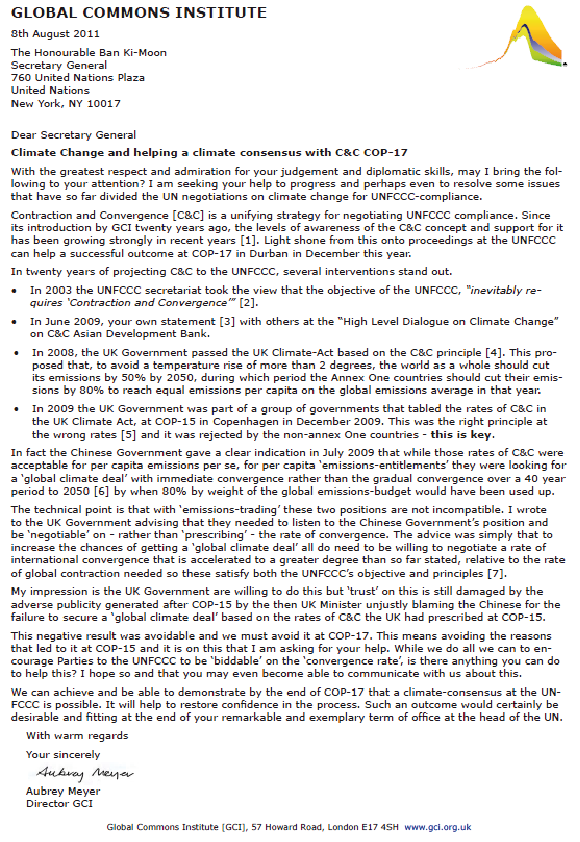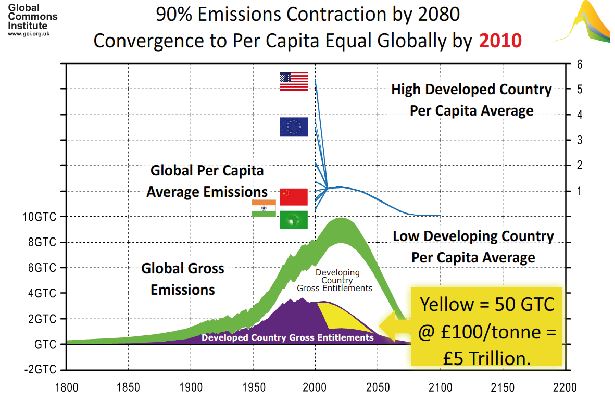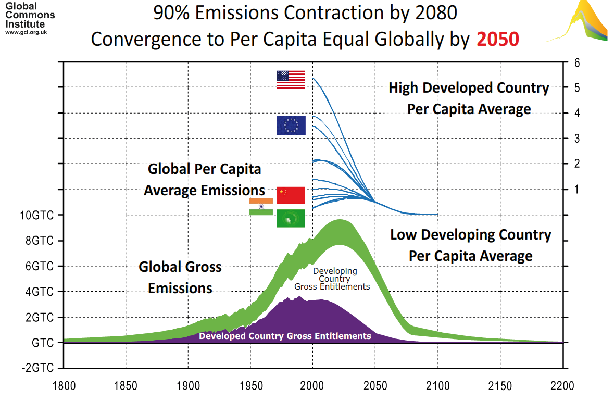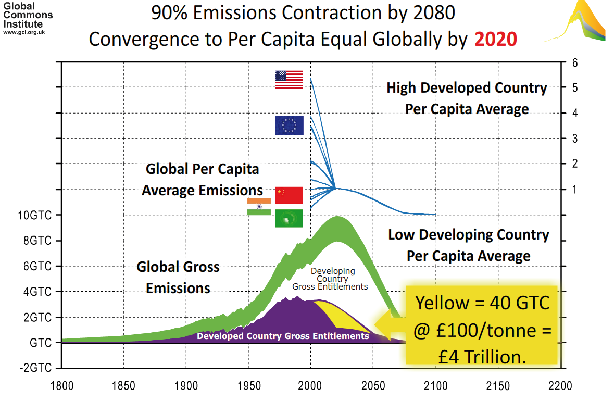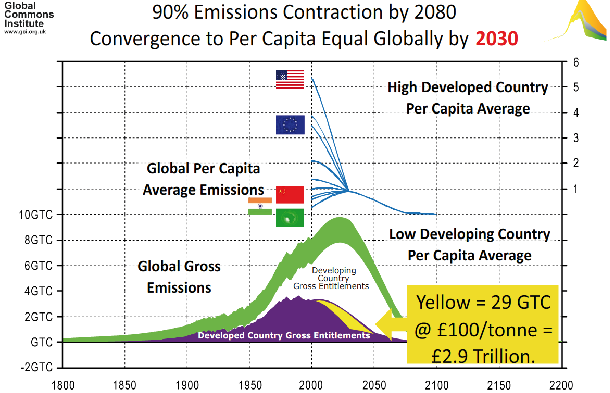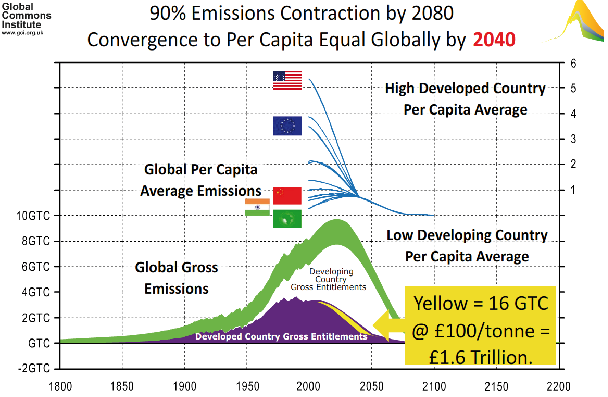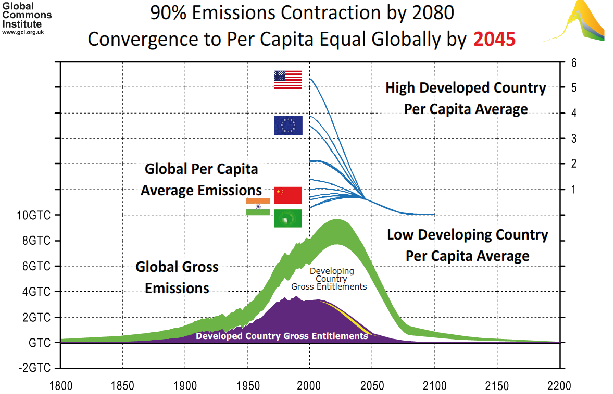8th August 2011
The Honourable Ban Ki-Moon
Secretary General
760 United Nations Plaza
United Nations
New York, NY 10017Dear Secretary General
Climate Change and helping a climate consensus with C&C COP-17
With the greatest respect and admiration for your judgement and diplomatic skills, may I bring the following to your attention? I am seeking your help to progress and perhaps even to resolve some issues that have so far divided the UN negotiations on climate change for UNFCCC-compliance.
Contraction and Convergence [C&C] is a unifying strategy for negotiating UNFCCC compliance. Since its introduction by GCI twenty years ago, the levels of awareness of the C&C concept and support for it has been growing strongly in recent years. Light shone from this onto proceedings at the UNFCCC can help a successful outcome at COP-17 in Durban in December this year.
In twenty years of projecting C&C to the UNFCCC, several interventions stand out.
- In 2003 the UNFCCC secretariat took the view that the objective of the UNFCCC, “inevitably requires
‘Contraction and Convergence"- In June 2009, your own statement with others at the “High Level Dialogue on Climate Change”
on C&C Asian Development Bank.- In 2008, the UK Government passed the UK Climate-Act based on the C&C principle. This proposed
that, to avoid a temperature rise of more than 2 degrees, the world as a whole should cut its emissions by 50% by 2050, during which period the Annex One countries should cut their emissions by 80% to reach equal emissions per capita on the global emissions average in that year.- In 2009 the UK Government was part of a group of governments that tabled the rates of C&C in the UK Climate Act, at COP-15 in Copenhagen in December 2009. This was the right principle at the wrong rates and it was rejected by the non-annex One countries - this is key.
In fact the Chinese Government gave a clear indication in July 2009 that while those rates of C&C were acceptable for per capita emissions per se, for per capita ‘emissions-entitlements’ they were looking for a ‘global climate deal’ with immediate convergence rather than the gradual convergence over a 40 year period to 2050 by when 80% by weight of the global emissions-budget would have been used up.
The technical point is that with ‘emissions-trading’ these two positions are not incompatible. I wrote to the UK Government advising that they needed to listen to the Chinese Government’s position and be ‘negotiable’ on - rather than ‘prescribing’ - the rate of convergence. The advice was simply that to increase the chances of getting a ‘global climate deal’ all do need to be willing to negotiate a rate of international convergence that is accelerated to a greater degree than so far stated, relative to the rate of global contraction needed so these satisfy both the UNFCCC’s objective and principles.
My impression is the UK Government are willing to do this but ‘trust’ on this is still damaged by the adverse publicity generated after COP-15 by the then UK Minister unjustly blaming the Chinese for the failure to secure a ‘global climate deal’ based on the rates of C&C the UK had prescribed at COP-15.
This negative result was avoidable and we must avoid it at COP-17. This means avoiding the reasons that led to it at COP-15 and it is on this that I am asking for your help. While we do all we can to encourage Parties to the UNFCCC to be ‘biddable’ on the ‘convergence rate’, is there anything you can do to help this? I hope so and that you may even become able to communicate with us about this.
We can achieve and be able to demonstrate by the end of COP-17 that a climate-consensus at the UNFCCC is possible. It will help to restore confidence in the process. Such an outcome would certainly be desirable and fitting at the end of your remarkable and exemplary term of office at the head of the UN.
With warm regards
Your sincerely
Aubrey Meyer
Director GCIHere is a sequence of images showing how this negotiation will need to resolve: -
The image on the left shows immediate convergence - Chinese Government position at COP-15.
The image on the right shows convergence by 2050 - UK et al position at COP-15.
Negotiating the rate of convergence was entirely possible as this animation shows: -This is still the challenge Parties to the UNFCCC face at COP-17 in Durban this year.
With reference to the failure that actually occurred at COP-15, the C&C mechanism demonstrated here [3,300 downloads last month alone] also compares C&C with 'alternatives' such as GDRs [see below].~~~~~~~~~~~~~~~~~~~~~~~~~~~~~~~~~~~~~~
As with the 'Berlin Wall', the 'Climate-Firewall' can yet come down.
'Climate-detente' possible
at COP-17 with negotiated rates of C&C.
Why not Follow @aubreygci
Why not
Tweet

